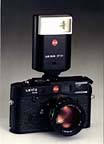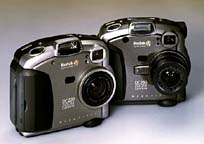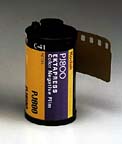Report from
Photokina '98
by Sal DiMarco
Photokina is the preeminent photo exposition
in the world. This year's event was wet, cold and "quiet"---though, The
Kulsh, a local beer, was great. Evolutionary, rather than revolutionary
is probably the best description for this 25th photographic show of shows.
The biggest trend visible at the show was
the enormous increase in consumer digital cameras and products. Film, however,
is still an extremely important element in the industry and was showcased
as well. Manufacturers are vigorously working on new products. You can
expect to see major improvements in the months ahead, particularly in the
realm of traditional photography. The "Kodaks" of the world are still conscious
of the fact that film has a product life measured in decades, whereas digital
stuff is all but out dated when it hits the store shelves.
Here's my list of some of the more notable
"goodies," useful to the working pro.
 |
Leica:
With the new slogan: "Leica. Optics make the difference," the sultans
have introduced three new or improved lenses: a 90mm Apo-Summicron-M
f/2 ASPH, a135mm APO-Telyt-M f/3.4 for the
M-cameras and a 35-70mm Vario-Elmarit-R f/2.8 ASPH for the reflexline.In
Leica speak "APO" means apochromatic, and "ASPH" stands for aspherical.
Insimple terms, it means great lenses.An improved version of the classicM6
with TTL flash metering was debuted. The flash
(SF 20) also works withthe R8 reflex
camera. |
| Leica
showed a consumer digital camera called the Digilux. It is a 1.5million
pixel camera. This camera is also known as the Fuji MX-700. Their
very high-end digital scanning cameras deserve a look for thosein search
of art reproduction quality imaging. After years of buckingthe trend,
they finally have a 35mm projector for carousel trays: the PradovitRT-S
and RT-M.
Lastly, Leica showed a 5x loupe for looking
at your slides. This beats theold Schneider
4x looker hands down! It will sell for about $175.
http://www.leica-camera.com |
 |
 |
Canon:
The big item introduced was the EOS3, which will be positioned
in the market place just below the
EOS 1N. It has a 45 point AF sensor layout,which
should mean faster autofocus. The most interesting new lens was a 35mm
f/1.4L
http://www.usa.canon.com/camcambin/index.html |
Contax:
After trying to take on Leica, Contax is now going after Hasselblad
with a new 645 system camera that has interchangeable everything---magazines,
lenses finders, etc. (Hey, it's their claim, not mine!) The camera
is autofocus with a focal plane shutter (X-sync =1/100). Leaf shutter
lenses are promised. Lenses from 35mm to 210mm (24mm to 135 on a35mm camera).No
improvement or new lenses for the G cameras were shown.
http://www.contaxcameras.com |
 |
Nikon: For the working photographer,
the most important developments frombrand
"N" were two new (I'd say improved) lenses, a 28-70mm f/2.8 zoomandan 80-200mm
f/2.8 zoom. Both lenses have a built-in "Silent Wave" motor, claiming
it gives "ultra-fast and hushed autofocus and boosts the focus tracking
performance." There were many rumors about a Nikon digital camera
based on the F5. They admit to it, but will not say who is doingthedigital
side---smart money is on Kodak.http://www.nikon.co.jp/photo-e
Hasselblad: They introduced a dual
format 35mm camera with a 45mm f/4
and 90mm lens. It is standard 24x36mm
format and 24x65mm panorama format. A
total improvement in the lens line, along with databus connections wasannounced.
One of the nice things was a PC strobe cord lock. No
more loose synch cords. A 2x magnifier for all the 45 degree prismviewfinders
and the PM90. They also showed a Zeiss 300mm f/2.8 lens for their
focal plane shutter cameras. It weighs as much as a Volvo, and willprobably
cost as much. http://www.hasselblad.se
Mamiya:
The big format 21/4 geniuses showed an improved 50mm f/4.5 wide-angle
and two short-barrel lenses, a 75mm f/4 and 180mm
f/4.5 for use on the shift/tilt adapter for the RZ 67 system. http://www.mamiya.com
Tamron: The maker of unique off-brand
lenses showed a AF28mm-300mm (that'sright
300mm!) f/3.5-6.3 LD aspherical zoom lens. It will be available inCanon
EOS, Nikon-D, Pentax AF, and if it is anything like the 28-200 lensthey
make, it will be an excellent walking around lens. http://www.tamron.co.jp
 |
Kodak:
On the digital side, the Great Yellow Father introduced threeconsumer
cameras: the DC210 Plus, DC220 Zoom, and the DC260 Zoom, in addition
to the already announced DCS 560 professional camera. Note the CCDchip
in the DCS560 is almost the sizeof a 35mm frame, so a 20mm lens is now
a wide-angle and not a normal one.They
do seem to be way ahead of everybody in the
digital area. |
| On
the film side, there were some exciting developments. The first, wasanimproved
Ektapress 800. The film offers greater flexibility and "outstanding
results when pushed. A finer grain is particularly
noticeable when the film is pushed." To further improve the scanning
performance of the film, Kodak and Polaroid created a new "look-up"
table for the film. |
 |
In the reversal film area, Ektachrome E100VS
was shown---"VS" stands for vividsaturation.
A quote regarding Fuji's Velvia from one Kodak executive: "We
do cheese better." New print films
were introduced in the 160 and 400 ISO area. Both are available
in "NC" (natural color for controlled lighting situations), and
"VC" for vivid color. They claim regardless of format, both 160 and400,
one can expect the print to look the
same. http://www.kodak.com/go/professional
Fuji: The company has merged its
Reala technology with its Superia color
35mm and APS color negative films.
One of the more interesting benefits of the Reala films
is a clean picture under fluorescent lights. They
announced a repackaging of Press 400 & 800 films.
On the reversal side, they showed Fujichrome
64T TypeII, a tungsten balanced (3200K)
with finer grain, resolution, color, etc. They claim
that processing between -1/2 to +1 stop has "minimal impact on eithercolor
or contrast." http://www.fujifilm.co.jp
Sal Dimarco, Jr. is a Philadelphia-based
freelance photographer
DISCLAIMER
Reviews of new equipment
appearing in the Camera Corner of THE DIGITAL JOURNALIST are solely the
opinion of the author. There is no compensation or pressure by the manufacturers
considered in the evaluation of the products reviewed on these pages. |





